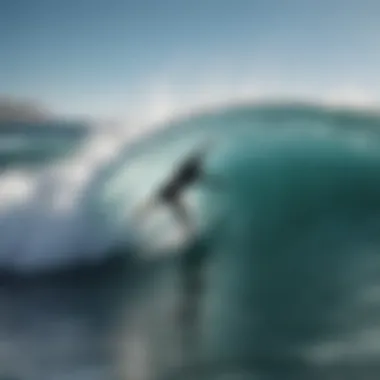Understanding Wave Heights: Key Insights for Water Sports


Intro
Understanding wave height is crucial for anyone interested in water sports. Various activities, such as surfing, windsurfing, or kitesurfing, can be heavily impacted by changing wave conditions. Accurate measurement of wave height can determine when to hit the waves and when to stay on shore. In this article, we will discuss the techniques, gear, safety measures, and more, focusing on how wave height relates directly to performance in water sports.
Techniques and Tips
When it comes to navigating wave conditions, skill development is essential. Here are some thoughts on how to improve and prepare:
Skill Development
Building foundational skills allows enthusiasts to respond better to varying wave heights. Practicing the basics of paddling, positioning, and balance is a priority. Many local surf schools offer courses that teach these core competencies. Joining group sessions or finding a mentor can also enhance your learning experience.
Practical Techniques
- Observing Conditions: Spend time observing local conditions before entering the water. Look for how waves break and the overall water movement.
- Reading Forecasts: Familiarize yourself with how to read wave forecasts from reliable sources. Understanding the terminology can be beneficial for planning.
- Trial and Error: Don't be afraid to learn from your experiences. Every ride offers lessons that shape your abilities in the water.
Common Mistakes to Avoid
- Ignoring safety protocols can increase risks.
- Underestimating changing weather conditions or tides can lead to danger. Stay informed and adaptable.
- Overconfidence in skills can cause accidents. It’s essential to respect the ocean’s power.
Gear and Equipment
The right equipment can greatly affect your performance and safety in the water. To succeed, consider the following aspects of gear selection:
Essential Gear for Beginners
Investing in suitable gear is vital. Beginners should look for:
- Wetsuits: Proper warmth and flexibility are crucial.
- Surfboards: A longer board can offer better stability while learning.
- Leashes: Essential to keep your board connected to you.
Latest Innovations and Trends
Technology in water sports gear has advanced. Brands like Rip Curl and Quiksilver are developing smart wetsuits with built-in sensors, helping monitor your performance and wave conditions. These innovations can greatly enhance understanding and enjoyment of water activities.
Reviews and Comparisons
Before purchasing, check reviews online or consult forums like Reddit. This shared knowledge can help you avoid costly mistakes.
Safety Measures
Safety should always come first when engaging in water sports. A proactive approach can reduce risks significantly.
Essential Safety Gear
Every water sports enthusiast needs basic safety gear:
- Personal Floatation Devices: Always have a life jacket ready.
- Helmet: Especially for activities like kite surfing.
- First-Aid Kit: Preparedness is key in emergencies.
Best Practices for Safe Participation
- Always inform someone about where you will be.
- Check your gear before heading out.
- Understand the local wave patterns and tides.
Injury Prevention and Management
Injuries can happen. To avoid them, it’s vital to:
- Stretch before entering the water.
- Recognize your limits and don’t push beyond them.
- Seek medical attention for persistent pain.
Spotlights on Extreme Sports
As we dive into specific sports, we aim to showcase their characteristics and key figures.
Featured Sport of the Month
This month, our spotlight is on surfing. Surfing requires a blend of skill and understanding of wave heights. Knowing when to take off can define a good wave from a great one.
Profiles of Prominent Athletes


Consider athletes like Kelly Slater, who emphasizes the significance of wave knowledge in a surfist's journey. Studying their techniques can provide insights into mastering the art of surfing while understanding environmental factors.
"Understanding the ocean is as important as mastering technique. Waves can change rapidly, and being prepared is the best approach." - Kelly Slater
This comprehensive guide sets the stage for both newcomers and seasoned veterans. Whether it's through skill development, proper equipment, or safety practices, getting a firm grasp on wave heights will increase enjoyment and minimize risks in water sports.
Understanding Wave Height
Understanding wave height is crucial for anyone involved in water sports. It affects everything from safety to performance. Different activities require different wave conditions. Therefore, knowing how to analyze wave height can significantly enhance one’s experience on the water.
Definition and Significance
Wave height refers to the distance between the crest of a wave and its trough. This measurement is significant for water sports enthusiasts, as it directly influences the suitability of conditions for activities like surfing, jet skiing, or kiteboarding. For surfers, for example, specific wave heights can create optimal surfing conditions. High waves can deliver thrill while also posing risks.
In assessing safety, understanding wave height helps to identify dangerous conditions, making this knowledge essential for all involved in water sports.
Meteorological Influences
Meteorological factors play a pivotal role in determining wave height. Elements such as wind patterns, storm activity, and tides all contribute to the physical characteristics of waves.
Wind speed and direction
Wind speed and direction directly affect wave formation. Strong winds generate larger waves, while the direction of the wind influences the swell direction, which is critical for surfers as it determines how the waves break. Understanding local wind patterns can provide valuable insights into the best times for water sports. Additionally, offshore winds tend to create clean, well-formed waves, enhancing the experience for water sports enthusiasts. Without this knowledge, one may misjudge conditions and expose themselves to unnecessary risks.
Storm patterns
Storm patterns can significantly alter wave height. As storms approach, wave energy can intensify, leading to potentially hazardous conditions. Storms can create large swells that pose a challenge for all water sports, particularly for unsophisticated participants. Analyzing historical storm patterns in a region can help predict when and how wave heights will change, providing essential info for planning safe outings.
Tides and currents
Tides and currents also influence wave height but in different ways. Tides can amplify wave height during high tide, while currents can affect the wave's stability. Understanding these variables helps water sports enthusiasts to navigate and anticipate how these factors may impact their activities. For example, strong currents may not only increase wave height but also create risks such as rip tides, demanding a higher level of expertise and caution.
Overall, comprehending these meteorological influences aids in personal safety and enriches the overall experience for water sports participants.
Current Wave Height Measurements
Current wave height measurements are crucial for understanding the surf conditions that influence water sports. Accurate data about wave heights allows enthusiasts to assess the safety and efficacy of their activities. In this section, we will explore the various technologies and data analysis techniques that help in measuring wave heights today.
Technology Used for Measurement
Buoys and wave sensors
Buoys and wave sensors are instrumental in measuring wave height. These devices collect real-time wave data directly from the ocean surface. Their ability to remain stationary while providing consistent information is a key characteristic. They are a popular choice due to their robust design that can withstand harsh marine environments.
The unique feature of buoys is their ability to transmit data wirelessly. This enables immediate access to wave conditions from remote locations. One advantage of using buoys is the precision in live readings. However, they can be costly to deploy and maintain, which is a consideration for many water sports organizations.
SAR and satellite imagery
Synthetic Aperture Radar (SAR) and satellite imagery have transformed wave height measurement. These technologies provide broad coverage and can capture data over vast ocean areas. A key characteristic is their capability to operate regardless of weather conditions, making them reliable under various circumstances.
The unique aspect of SAR is its ability to interpret surface wave patterns on a large scale. This can reveal significant wave height trends across regions. While they offer extensive data, the disadvantage can be the delay in data processing, which might miss immediate changes crucial for water sports.
Weather stations
Weather stations play an essential role in wave height assessment by providing additional meteorological context. They measure wind speed, direction, and atmospheric pressure, all of which impact wave formation. Their key characteristic is the integration of multiple factors influencing wave conditions, making them a comprehensive choice for analysis.
A unique feature of weather stations is the localized data they offer. They enable pinpoint analysis of specific areas, which is valuable for enthusiasts. Nevertheless, their coverage is limited compared to buoys and satellites, which may present a narrower perspective of wave conditions over larger areas.
Data Analysis Techniques
Statistical modeling
Statistical modeling is a vital data analysis technique used to interpret wave height data. It involves using historical data to predict future wave conditions. A key characteristic of statistical modeling is its reliance on mathematical frameworks that can handle complex datasets.
This technique is beneficial as it provides a structured approach to forecasting, which is crucial for planning water sports activities. A distinct advantage is its ability to quantify uncertainty, helping enthusiasts make informed decisions. However, it requires accurate historical data, which may not always be available.
Real-time data processing
Real-time data processing has gained popularity due to its capacity to analyze wave height information instantly. This technique allows for immediate insights, particularly relevant for water sports enthusiasts. Its key characteristic is the rapid assimilation of incoming data streams, providing up-to-the-minute information.


The unique advantage of real-time data processing is the ability to react swiftly to changing conditions, enhancing safety and performance in water sports. However, it may be resource-intensive and may not always guarantee complete accuracy in the face of rapidly evolving weather patterns.
Predictive analytics
Predictive analytics combines various data sources to forecast wave conditions. This technique leverages historical data alongside real-time inputs to yield predictions about future wave behavior. A key characteristic is its focus on trend analysis, which helps in understanding potential future states.
The benefit of predictive analytics lies in its effectiveness in decision-making for water sports planning. By anticipating future conditions, athletes can choose optimal times for their activities. However, the complexity of the models can lead to challenges in usability and may require specialized knowledge to interpret correctly.
Local Observations: Wave Height Today
Understanding wave height in local contexts is essential for water sports enthusiasts. It serves as a direct correlate to safety and enjoyment during activities like surfing or kiteboarding. This section focuses on the relevant local observations regarding wave height, investigating regional variability and current wave height reports. These elements paint a clearer picture of conditions that affect water sports at any given moment, allowing enthusiasts to make informed decisions.
Regional Variability
Coastal zones and their characteristics
Coastal zones play a crucial role in determining the wave height experienced by water sports enthusiasts. These areas are defined by their proximity to the ocean and various physical features like shorelines and seabeds. The characteristics of coastal zones include factors such as depth, slope, and natural barriers like reefs. Such features can either enhance or diminish wave size, making them an essential aspect of wave analysis.
The dynamic ecosystem of coastal zones is both intricate and beneficial for athletes. They often present various surfing conditions due to a combination of waves reflections, refractions, and energy dissipation. As a result, surfers often find that local knowledge of these zones greatly enhances their experience and overall performance.
However, it is important to be aware that not all coastal zones are the same. Some may experience stronger swells due to their exposure to ocean currents. Others, conversely, might lead to smaller, more manageable waves. Each specific coastal zone brings unique characteristics and challenges.
Specific surf spots evaluation
Evaluating specific surf spots is essential for understanding local wave height conditions. Each surf location possesses its own set of waves influenced by local geography, weather, and tide patterns. This makes it crucial for enthusiasts to investigate these spots regularly. Specific location attributes like the shape of the ocean floor and the proximity to land can greatly affect how waves form.
The allure of certain surf spots comes from their ability to produce consistent wave heights suitable for various skill levels. For instance, beaches that receive swells from prevailing winds can lead to workable waves for both beginners and experienced surfers. Such evaluation allows enthusiasts to seek out spots that best match their desired difficulty.
As with coastal zones, the variability among surf spots means that higher risk is involved in selecting an unsuitable location. It is necessary to engage in continuous assessment and local knowledge to ensure the best experiences while maximizing safety.
Influence of geographical structures
Geographical structures significantly influence wave height and overall conditions. These include offshore islands, reefs, and underwater land formations. Such structures can serve as natural buffers that change how waves travel and break. In some cases, they can amplify wave size, providing optimal conditions for surfing and other water sports.
One notable characteristic is how these structures can create waves with different patterns and heights. For example, certain reef breaks offer predictable and consistent waves preferred by many surfers. In contrast, some rocky shorelines could lead to unpredictable swells that might be more challenging for newcomers.
Being aware of how geographical features impact wave behavior allows water sports enthusiasts to pick ideal locations in line with their skills and preferences. Understanding these influences can also enhance safety considerations, as specific formations can create hazardous conditions under certain circumstances.
Current Wave Height Reports
Keeping track of current wave height reports is vital for water sports enthusiasts. These reports provide real-time data on wave conditions, helping athletes choose the right time and place for their activities. Modern technology has streamlined the process of obtaining accurate wave height information, making it more accessible than ever.
Sources of current wave height reports range from buoys and surf cams to weather stations that offer detailed readings.
Regularly checking wave height reports is crucial for ensuring optimal performance and enhancing safety.
Many knowledgeable athletes actively seek this information before planning their activities. Understanding wave patterns and conditions can lead to better decision-making, creating a more enjoyable experience overall.
Ultimately, comprehensive local observations on wave height significantly inform water sports enthusiasts and impact their experiences in the water.
Implications for Water Sports
Understanding wave height is crucial for water sports enthusiasts. Different sports demand varying wave conditions for safety and optimal performance. For surfers, the height and scale of waves can impact not just the quality of the ride but also overall safety. Meanwhile, activities like kiteboarding or jet skiing have unique requirements tied to waves and wind conditions.
When discussing the implications for water sports, several specific elements emerge:
- Safety: Knowledge of current wave conditions helps participants avoid dangerous situations. Big waves can lead to accidents or equipment damage.
- Performance: Ideal wave conditions contribute to better performance across water sports. Athletes can harness nature’s power effectively with the right wave height and direction.
- Planning: Accurate wave height data helps enthusiasts schedule their activities properly. It also aids instructors in making informed recommendations for novice participants.
For these reasons, comprehending wave height's implications is essential. A well-informed community can lead to safer and more enjoyable water sports experiences.
Ideal Conditions for Surfing
Optimal Wave Height Ranges
The optimal wave height for surfing generally falls between 3 to 6 feet for most surfers. This range is popular because it provides a balance between challenge and accessibility. Waves too small might not generate enough speed or power, while excessively large waves can be intimidating and dangerous.
Surfing within this range supports learning and skill development. Beginners may find 2 to 4 feet waves more manageable, fostering confidence. Conversely, advanced surfers often seek waves at the top of this scale for exciting challenges. However, their unique features present both advantages and disadvantages.


- Advantages: Encourages participation across skill levels, provides thrill for experienced surfers.
- Disadvantages: Swells in this range may vary in consistency, affecting surf quality.
Swell Direction and Size
Swell direction relates to where the waves originate and is vital in determining surf quality. Aligning with the coastline, the swell direction influences how waves break. A swell coming directly from the ocean typically results in powerful and clean waves.
Surf spots have different optimal swell directions, making it essential for surfers to research before heading out. The unique feature here is the influence of local geography, which can shape how waves break and unfold.
- Advantages: Waves breaking in the right direction offer better rides, ensuring a more enjoyable experience.
- Disadvantages: Incorrect swell direction can lead to choppy conditions, which may deter surfers from entering the water.
Safety Considerations
Safety in water sports cannot be understated. Knowledge of both wave height and conditions contributes significantly to ensuring participants remain safe. Strong waves may pose risks such as rip currents or backwash, presenting challenges, especially for novices.
Surfers should constantly assess their environment and be aware of their capabilities. Lifeguards, local rules, and warnings should be heeded. Frequent checks of conditions from trusted surf reports provide essential insights into safe surfing practices.
- Advantages: Enhances awareness and preparation, reducing accidents significantly.
- Disadvantages: Misjudgments regarding safety can lead to hazardous situations, especially in dynamic environments.
Impact on Other Extreme Sports
Kiteboarding
Kiteboarding shares a profound connection with wave conditions. It combines elements of surfing and wind sports, relying not just on waves but also on wind strength and direction. Optimal wave height can enhance the riding experience by allowing for larger jumps and smoother landings.
The key characteristic of kiteboarding is its adaptability to changing conditions. Riders can perform effectively in a range of waves, but specific conditions elevate the experience.
- Advantages: Unique thrills that come from impressive aerial maneuvers.
- Disadvantages: Requires careful assessment of wind and water conditions to avoid accidents.
Windsurfing
Windsurfing also relies heavily on wave height and wind conditions. Surfers use a board mounted with a sail, allowing them to harness both wind and wave energy. Ideal conditions lead to exhilarating rides, making it a popular choice among adventure seekers.
The main advantage of windsurfing is versatility. Riders can enjoy it across various conditions, but optimal waves tend to enhance the thrill of catching speed.
- Advantages: Allows for both challenging and relaxing experiences depending on conditions.
- Disadvantages: Additionally difficult for beginner riders to manage in choppy waters, necessitating learning in more gentle conditions.
Jet Skiing
Jet skiing is another water sport influenced by wave height. Riders seek thrilling rides, often pushing their machines to their limits. Optimal conditions allow for faster rides and more agility on the water. Jet skis, however, can face issues with larger waves, which may limit their maneuverability.
The main characteristic of jet skiing is its combination of power and adrenaline. Riders often seek waves to ride over but must balance this with potential risks.
- Advantages: Allows for fast-paced excitement, offering a front-row seat to ocean conditions.
- Disadvantages: Undue wave height can lead to accidents, damaged equipment, or injury.
Future Trends in Wave Height Assessment
Assessing wave height is crucial, especially for water sports enthusiasts. The future trends in this area show promise, driven by advancements in technology and growing environmental awareness. Understanding these trends is important for surfers and other water sports lovers, as they help predict safe and ideal conditions. This section explores developments that could shape the future of wave height assessment.
Advancements in Measurement Technology
Improved satellite systems
Improved satellite systems enhance wave height monitoring significantly. They provide broader data coverage and more frequent updates. The enhanced resolution of these systems allows for more precise readings, which helps water sports enthusiasts plan their activities better. The satellite's ability to capture data across vast ocean expanses is key. However, these systems can be costly to deploy and maintain, making them less accessible in some regions.
Machine learning applications
Machine learning applications are transforming wave height analysis. They allow for the processing of large datasets, identifying patterns in wave behavior that were previously unnoticed. Using algorithms, these applications can predict wave heights with greater accuracy. This predictive capability is valuable for water sports enthusiasts looking for optimal conditions. Yet, reliance on technology continues to grow, prompting concerns about data integrity and system malfunctions.
Crowdsourced data contributions
Crowdsourced data contributions enable real-time wave height information. They leverage input from everyday surfers and sailors. This local knowledge can provide timely updates about local conditions. This grassroots approach leads to more dynamic and responsive data. However, the variability in data quality can make it challenging to ensure accuracy in measurements.
Climate Change Implications
Rising sea levels
Rising sea levels directly impact wave behavior and beach safety. As water levels increase, wave patterns can shift, creating unexpected challenges for water sports. Understanding these changes is vital for safety. The long-term effects on local environments may lead to new surf spots or the loss of existing ones. Also, climate refugees may populate previously popular coastal areas, changing dynamics.
Changing storm patterns
Changing storm patterns represent another significant concern. More frequent and severe storms can lead to higher wave heights and more unpredictable conditions. This variability can challenge even the most experienced surfers. Anticipating these changes is essential for safety and performance in water sports. It elevates the need for accurate wave height assessment as extreme weather could shift expected norms.
Impact on wave dynamics
The impact on wave dynamics due to climate change is profound. Alterations in ocean currents and temperatures can affect wave formation. Such changes must be monitored closely. For water sports enthusiasts, knowing how these dynamics shift helps in planning activities and enhances safety. However, as these dynamics evolve, they might create new opportunities for thrill-seekers in uncharted waters.







